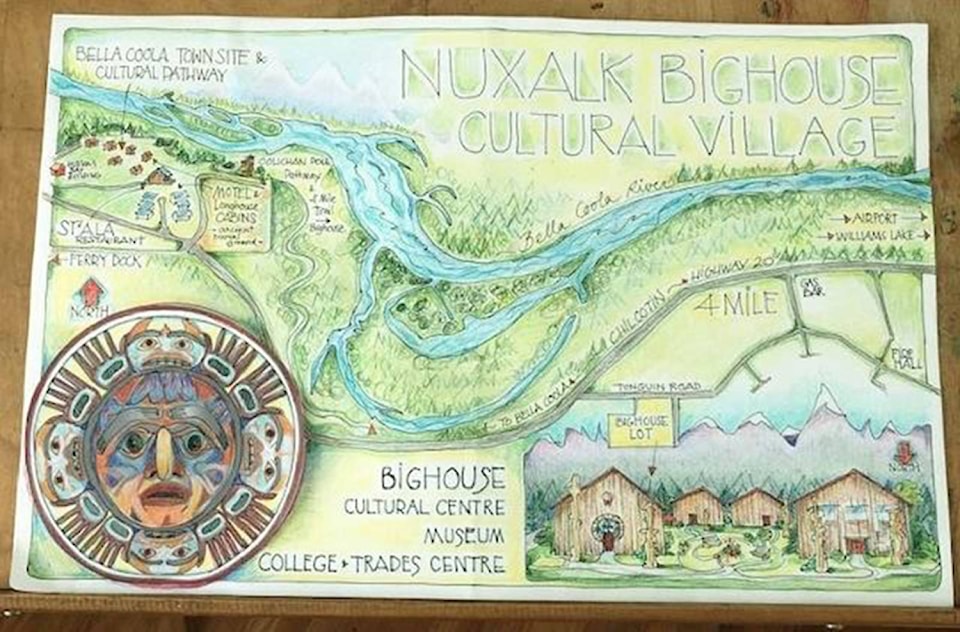The Nuxalk Nation is celebrating after a five-year planning process has resulted in the award of $3,569,173 in federal funding and $713,834 in provincial funding for the construction of the Nation’s Big House.
“The Nuxalk Community has wanted and requested that a Big House be built for over 40 years and it’s finally happening,” said Nuxalk Nation Administrator Wilma Mack. “The construction of this Big House is central to our plans for healing; with it we are healing our house and our society as a whole.”
The funding is joint federal, provincial and municipal funding through the Investing in Canada Infrastructure Program will support 24 infrastructure projects in British Columbia’s northern communities; $40.5 million will be going to 12 projects in Indigenous communities including our neighbouring communities in Alexis Creek and Tl’etinqox.
The Big House will be located on Tonquin Road on a piece of land that was recently repatriated after being lost to the Nation decades ago. It is just one piece of a larger concept; the construction of a cultural village that includes a Cultural Centre, Museum and a new campus and the expansion of Lip’alhayc (Nuxalk College). It will be located close to the future elders village.
Culturalist Clyde Tallio, who has worked on the project since its inception, explained that there is a distinct difference between a “big house” (known as Lhk’uulh in the Nuxalk language), and a “longhouse” (known as Tsaakwaluulh) and that each building existed for a very distinct purpose.
“A traditional longhouse housed family units and was constructed in a way that it could be extended, hence the term longhouse,” Tallio explained. “A big house served a different purpose and was used for community gatherings, potlatches, celebrations and mournings.”
A separate project, undertaken by Acwsalcta School, will see a longhouse-style building built on school grounds for use in its after school programming.
Plans, timing and construction for the Big House are all still in the preliminary stages (and now dependent on COVID-19 developments), but Tallio did confirm that the design will feature four “house poles” that represent each of the Nuxalk territories.
The funding announcement details that the Big House construction will include “the construction of the Nuxalk Nation Big House as a gathering place for the community including a central fire pit, bleachers, washrooms, commercial kitchen, dorms, dancer prep space, storage, and a false frontage on the building for traditional carvings.”
“The Big House will be held up by four Nulhtnikta’s (interior house posts). These four posts are designed to represent the four main Nuxalk territories: Raven (Nuxalk – represening Bella Coola and up Valley), Grizzly Bear (Tallio), Whale (Kwatna), and Eagle (Kimsquit),” said Tallio. “This way the four territories and all the families that descend from them hold up the house together.”
Two of the poles are presently being worked on, with master carvers Alvin Mack and Kelly Robinson in charge of the process and managing the additional carvers who are working on them, and the building will operate under the Nuxalk traditional calendar.
“We are planning to follow our traditional calendar that includes potlatch season, moving into Kusyut (secret society) and winter dancing, and finally the Children’s Potlatch in the spring before the eulachon return,” said Tallio. “However, we will also have the capacity to host community celebrations and gatherings like weddings and funerals.”
For Mack, the construction of the Big House represents a shift in the way the distinct governments of hereditary leadership (Stataltmc), chief and council, and cultural advisors and staff are coming together to govern and make decisions.
“We have a Big House committee that includes hereditary leaders, elders, artists, administration, culture and the housing department,” Mack explained. “We recognize that this project encompasses so many different areas and that healing is the basis for it all; what goes on in the inside will be so traditional and so meaningful to our people.”
Construction on the Big House has yet to be announced, but it is expected to begin in 2021.
